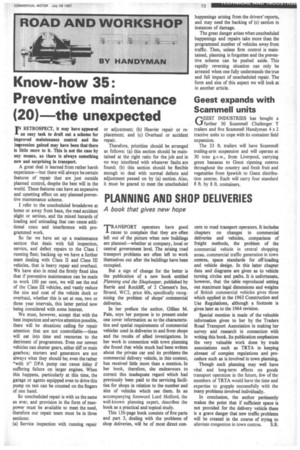PLANNING AND SHOP DELIVERIES
Page 75

If you've noticed an error in this article please click here to report it so we can fix it.
A book that gives new hope
TRANSPORT operators have good -Icause to complain that they are often left out of the picture when new buildings are planned—whether at company, local or central government level. The arising road transport problems are often left to work themselves out after the buildings have been occupied.
But a sign of change for the better is the publication of a new book entitled Planning and the Shopkeeper, published by Barrie and Rockliff, of 2 Clement's Inn, Strand, WC2, price 60s, specifically recognizing the problem of shops' commercial deliveries.
In her preface the author, Gillian M. Pain, says her purpose is to present under one cover information as to the characteristics and spatial requirements of commercial vehicles used in deliveries to and from shops and the results of allied investigations. In her work in connection with town planning she found that while much had been written about the private car and its problems the commercial delivery vehicle, in this context, has received little more than a mention. In her book, therefore, she endeavours to correct this inadequate regard which had previously been paid to the servicing facilities for shops in relation to the number and size of vehicles which use them. In an accompanying foreword Lord Holford, the well-known planning expert, describes the book as a practical and topical study.
This 136-page book consists of five parts and part 3, dealing with the problems of shop deliveries, will be of most direct con cern to road transport operators. It includes chapters on changes in commercial deliveries and vehicles, comparison of freight methods, the problem of the commercial vehicle in central shopping areas, commercial traffic generation in town centres, space standards for off-loading and vehicle design. In this latter chapter data and diagrams are given as to vehicle turning circles and paths. It is unfortunate, however, that the table reproduced setting out maximum legal dimensions and weights of British commercial vehicles gives those which applied in the 1963 Construction and Use Regulations, although a footnote is given later as to the 1964 revision.
Special mention is made of the valuable information given to her by the Traders Road Transport Association in making her survey and research in connection with writing this book. Its publication emphasizes the very valuable work done by trade associations such as TRTA in keeping abreast of complex regulations and procedure such as is involved in town planning.
Though such planning may well have vital and long-term effects on goods transport operation in the future, few of the members of TRTA would have the time and expertise to grapple successfully with the many problems involved individually.
In conclusion, the author pertinently makes the point that if sufficient space is not provided for the delivery vehicle there is a grave danger that new traffic problems will be created in the course of trying to alleviate congestion in town centres. S.B.




































































































































































